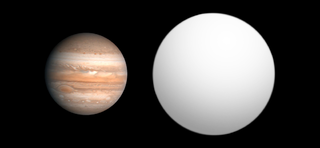
The Rossiter–McLaughlin effect is a spectroscopic phenomenon observed when an object moves across the face of a star.

WASP-1b is an extrasolar planet orbiting the star WASP-1 located 1,300 light-years away in the constellation Andromeda.

WASP-3b is an extrasolar planet orbiting the star WASP-3 located approximately 800 light-years away in the constellation Lyra. It was discovered via the transit method by SuperWASP, and follow up radial velocity observations confirmed that WASP-3b is a planet. The planet's mass and radius indicate that it is a gas giant with a similar bulk composition to Jupiter. WASP-3b has such an orbital distance around its star to classify it in the class of planets known as hot Jupiters and has an atmospheric temperature of approximately 1983 K.

WASP-6b, also named Boinayel, is an exoplanet approximately 650 light years away in the constellation Aquarius. It was discovered in 2008, by the WASP survey, by astronomical transit across its parent star WASP-6. This planet orbits at only 4% of the Earth-Sun distance. The planet has a mass half that of Jupiter, but its insolation has forced a thermal expansion of its radius to greater than that of Jupiter. Thus, this planet is an inflated hot Jupiter. Starspots on the host star WASP-6 helped to refine the measurements of the mass and the radius of the planet.

WASP-14b is an extrasolar planet discovered in 2008 by SuperWASP using the transit method. Follow-up radial velocity measurements showed that the mass of WASP-14b is almost eight times larger than that of Jupiter. The radius found by the transit observations show that it has a radius 25% larger than Jupiter. This makes WASP-14b one of the densest exoplanets known. Its radius best fits the model of Jonathan Fortney.
WASP-17 is an F-type main sequence star approximately 1,300 light-years away in the constellation Scorpius.

WASP-17b is an exoplanet in the constellation Scorpius that is orbiting the star WASP-17. Its discovery was announced on 11 August 2009. It is the first planet discovered to have a retrograde orbit, meaning it orbits in a direction counter to the rotation of its host star. This discovery challenged traditional planetary formation theory. In terms of diameter, WASP-17b is one of the largest exoplanets discovered and at half Jupiter's mass, this made it the most puffy planet known in 2010. On 3 December 2013, scientists working with the Hubble Space Telescope reported detecting water in the exoplanet's atmosphere.
WASP-16 is a magnitude 11 yellow dwarf main sequence star, with characteristics similar to the Sun, located in the Virgo constellation.

WASP-19b, formally named Banksia, is an exoplanet, notable for possessing one of the shortest orbital periods of any known planetary body: 0.79 days or approximately 18.932 hours. It has a mass close to that of Jupiter, but by comparison has a much larger radius ; making it nearly the size of a low-mass star. It orbits the star WASP-19 in the Vela constellation. At the time of discovery it was the shortest period hot Jupiter discovered as planets with shorter orbital periods had a rocky, or metallic composition.
WASP-33b is an extrasolar planet orbiting the star HD 15082. It was the first planet discovered to orbit a Delta Scuti variable star. With a semimajor axis of 0.026 AU and a mass likely greater than Jupiter's, it belongs to the hot Jupiter class of planets.

WASP-31b is a low-density (puffy) "hot Jupiter" extrasolar planet orbiting the metal-poor dwarf star WASP-31. The exoplanet was discovered in 2010 by the WASP project. WASP-31b is in the constellation of Crater, and is about 1305 light-years from Earth.
HD 146389, is a star with a yellow-white hue in the northern constellation of Hercules. The star was given the formal name Irena by the International Astronomical Union in January 2020. It is invisible to the naked eye with an apparent visual magnitude of 9.4 The star is located at a distance of approximately 446 light years from the Sun based on parallax, but is drifting closer with a radial velocity of −9 km/s. The star is known to host one exoplanet, designated WASP-38b or formally named 'Iztok'.
WASP-32 is a yellow main-sequence star in the constellation of Pisces. The star was given the formal name Parumleo in January 2020, Latin for small lion and referencing the national animal of Singapore.
WASP-25 is a yellow main sequence star in the constellation of Hydra.
Qatar-1 is an orange main sequence star in the constellation of Draco.
HAT-P-16 is a F-type main-sequence star about 740 light-years away. The star has a concentration of heavy elements slightly higher than solar abundance, and low starspot activity. The survey in 2015 have failed to find any stellar companions to it. The spectral analysis in 2014 have discovered the HAT-P-16 has a carbon to oxygen molar ratio of 0.58±0.08, close to Sun`s value of 0.55.
WASP-78, is a single F-type main-sequence star about 2500 light-years away. It is likely to be younger than the Sun at 3.4+1.5
−0.8 billion years. WASP-78 is depleted in heavy elements, having a 45% concentration of iron compared to the Sun.
WASP-62, formally named Naledi, is a single star about 573 light-years away. It is an F class main-sequence star, orbited by a planet, WASP-62b. The age of WASP-62 is much younger than the Sun at 0.8±0.6 billion years, and it has a metal abundance similar to the Sun.
WASP-61 is a single F-type main-sequence star about 1560 light-years away. The star age is much likely younger than the Sun's at approximately 3.8+1.8
−0.9 billion years. WASP-61 is depleted in heavy elements, having just 40% of the solar abundance of iron.








